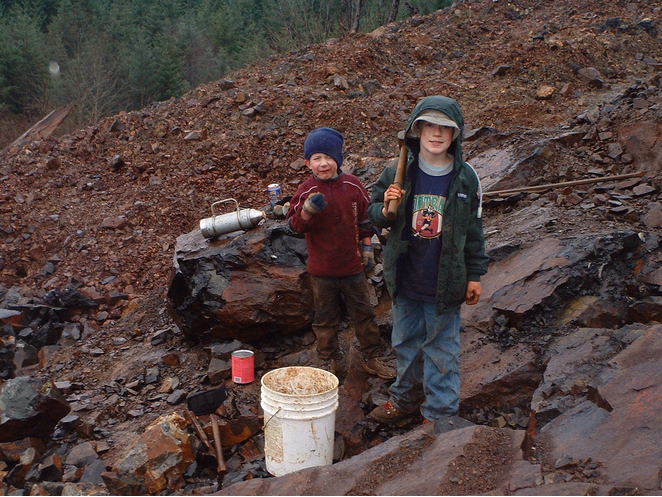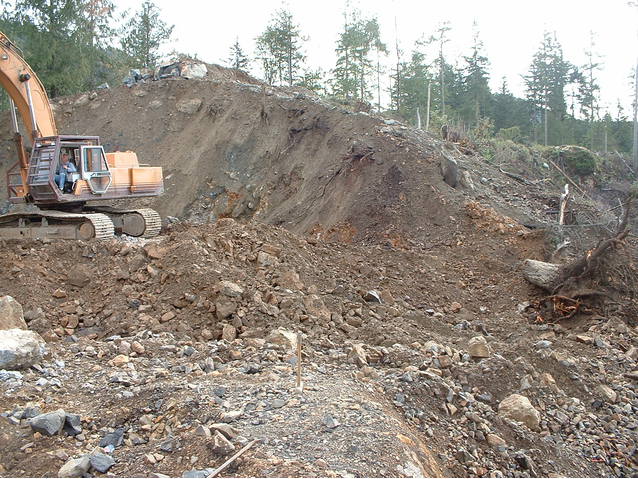Walker Valley, Skagit County, Washington, USAi
| Regional Level Types | |
|---|---|
| Walker Valley | Valley |
| Skagit County | County |
| Washington | State |
| USA | Country |
This page is currently not sponsored. Click here to sponsor this page.
Latitude & Longitude (WGS84):
48° 22' 19'' North , 122° 9' 54'' West
Latitude & Longitude (decimal):
Type:
Köppen climate type:
Mindat Locality ID:
7895
Long-form identifier:
mindat:1:2:7895:8
GUID (UUID V4):
7eccb213-8815-4e33-b3ea-97731d4dc739
The Walker Valley collecting area is located about 15 km east of Mount Vernon, Washington. The collecting site became popular among local mineral collectors in the late 1960s after a period of quarrying for road fill that exposed geode- and agate-bearing outcrops (Mustoe & Vandenburg, 1996). “The outcrop appears to be a 100-m-wide mass of brecciated rhyolite bordered on either side by unaltered black basalt” (Mustoe & Vandenburg. 1996). In actuality, though, the rock is an andesite of “fairly uniform composition,” the lighter color of the brecciated rock is due to hydrothermal alteration, and an explosive hydrothermal event resulted in the brecciation of the deposit (Mustoe & Vandenburg, 1996). The early stages of mineralization at Walker Valley were probably the result of contact by hot hydrothermal solutions with the cooler wall rock, which caused minerals to precipitate (Mustoe & Vandenburg. 1996). A likely significant factor in the last stages of mineralization was when mineral-laden fluids encountered fractures, which caused precipitation due to lower pressures and boiling (Mustoe & Vandenburg 1996).
A typical feature of Walker Valley geodes is a layer of the unusual mineral hisingerite, which forms a boundary between the andesite and the subsequent minerals (Mustoe & Vandenburg, 1996). The layer of hisingerite serves as an aid to collecting specimens at Walker Valley, because it is much softer and more brittle than the ultra-tough rock, forming a parting layer (Mustoe & Vandenburg, 1996).
Visits to the locality produced widely divergent site descriptions over time. Based on trips taken in the 1970s, the site could be described as a steep series of benches and short drop-offs occupying a zone about 100 meters wide and trending up a steep hill over a distance of perhaps 300 meters. There was an ample amount of rock debris from earlier collectors, but sufficient exposed rock to make collecting possible, but only with some hard work. This was mainly because the rock itself was very hard, and although the hisingerite layer made collecting specimens possible, it was nonetheless very difficult to remove decent sized specimens intact. A trip made in 2000 revealed a stark contrast with the visits from over 20 years before. By 2000, the debris from past collecting efforts had completely covered the underlying outcrop, with no fresh rock exposed. In addition, it would be difficult to determine where to dig to remove overburden in order to get to what had been the most prolific areas. There was no reason to think in 2000 that the deposit could not still produce good specimens, but a substantial amount of “mucking out” would be required.
There are adjacent deposits: the Junior Agate chalcedony seam on the way to the upper Andesite outcrop from the lower (main), and the Blue Candy and Fly-by-Nite chalcedony deposits lower in the valley.
Select Mineral List Type
Standard Detailed Gallery Strunz Chemical ElementsMineral List
8 valid minerals.
Rock Types Recorded
Note: data is currently VERY limited. Please bear with us while we work towards adding this information!
Select Rock List Type
Alphabetical List Tree DiagramDetailed Mineral List:
| ⓘ Calcite Formula: CaCO3 Habit: steep rhombohedral crystals, unusual aggregates of steep rhombohedral crystals, massive--filling voids, jackstraw clusters, and dendritic shapes Colour: white, colorless, pale yellow |
| ⓘ Cristobalite Formula: SiO2 |
| ✪ Goethite Formula: α-Fe3+O(OH) Habit: radiating divergent sprays Colour: golden brown Description: Micro-sized, but can form in exquisite, attractive sprays. A common associate of Quartz at Walker Valley |
| ⓘ Hematite Formula: Fe2O3 Habit: hexagonal plates Colour: black Description: tiny |
| ✪ Hisingerite Formula: Fe3+2(Si2O5)(OH)4 · 2H2O Habit: amorphous Colour: black, green, brown Description: A common mineral at Walker Valley, found as linings and masses directly adjacent to the andesite. Often develops shrinkage cracks due to dehydration. Can also change color over time. Analysis methods included atomic absorbtion spectrophotometry. |
| ⓘ Pyrite Formula: FeS2 Habit: cubes, pyritohedrons Colour: brassy metallic yellow Description: micro crystals are uncommon. In 1992, three crystals that were approximately 1 cm in size were found in a geode |
| ⓘ Quartz Formula: SiO2 Habit: druzy, mostly showing terminal faces, some sceptered, cryptocrystalline Colour: colorless, light to medium purple. Chalcedony can be white, gray, and blue. Description: Lining geodes and in stalactitic forms. As Chalcedony. |
| ⓘ Quartz var. Amethyst Formula: SiO2 Habit: druzy, mostly showing terminal faces Colour: pale to medium purple Description: pale to medium amethyst lining geodes |
| ⓘ Quartz var. Chalcedony Formula: SiO2 Habit: cryptocrystalline Colour: white, gray, blue Description: "seam agate" |
| ⓘ Quartz var. Sceptre Quartz Formula: SiO2 |
| ⓘ Siderite Formula: FeCO3 Habit: Spherical groups (spherosiderite), columnar masses of stacked plates, radiating rods, or jackstraw arrangements Colour: brown to amber Description: Usually occupying the central portions of geodes. At times enclosed in quartz forming "sagenite." |
Gallery:
List of minerals arranged by Strunz 10th Edition classification
| Group 2 - Sulphides and Sulfosalts | |||
|---|---|---|---|
| ⓘ | Pyrite | 2.EB.05a | FeS2 |
| Group 4 - Oxides and Hydroxides | |||
| ⓘ | Goethite | 4.00. | α-Fe3+O(OH) |
| ⓘ | Hematite | 4.CB.05 | Fe2O3 |
| ⓘ | Quartz var. Amethyst | 4.DA.05 | SiO2 |
| ⓘ | var. Chalcedony | 4.DA.05 | SiO2 |
| ⓘ | 4.DA.05 | SiO2 | |
| ⓘ | var. Sceptre Quartz | 4.DA.05 | SiO2 |
| ⓘ | Cristobalite | 4.DA.15 | SiO2 |
| Group 5 - Nitrates and Carbonates | |||
| ⓘ | Calcite | 5.AB.05 | CaCO3 |
| ⓘ | Siderite | 5.AB.05 | FeCO3 |
| Group 9 - Silicates | |||
| ⓘ | Hisingerite | 9.ED.10 | Fe3+2(Si2O5)(OH)4 · 2H2O |
List of minerals for each chemical element
| H | Hydrogen | |
|---|---|---|
| H | ⓘ Goethite | α-Fe3+O(OH) |
| H | ⓘ Hisingerite | Fe23+(Si2O5)(OH)4 · 2H2O |
| C | Carbon | |
| C | ⓘ Calcite | CaCO3 |
| C | ⓘ Siderite | FeCO3 |
| O | Oxygen | |
| O | ⓘ Quartz var. Amethyst | SiO2 |
| O | ⓘ Calcite | CaCO3 |
| O | ⓘ Quartz var. Chalcedony | SiO2 |
| O | ⓘ Cristobalite | SiO2 |
| O | ⓘ Goethite | α-Fe3+O(OH) |
| O | ⓘ Hematite | Fe2O3 |
| O | ⓘ Hisingerite | Fe23+(Si2O5)(OH)4 · 2H2O |
| O | ⓘ Quartz | SiO2 |
| O | ⓘ Siderite | FeCO3 |
| O | ⓘ Quartz var. Sceptre Quartz | SiO2 |
| Si | Silicon | |
| Si | ⓘ Quartz var. Amethyst | SiO2 |
| Si | ⓘ Quartz var. Chalcedony | SiO2 |
| Si | ⓘ Cristobalite | SiO2 |
| Si | ⓘ Hisingerite | Fe23+(Si2O5)(OH)4 · 2H2O |
| Si | ⓘ Quartz | SiO2 |
| Si | ⓘ Quartz var. Sceptre Quartz | SiO2 |
| S | Sulfur | |
| S | ⓘ Pyrite | FeS2 |
| Ca | Calcium | |
| Ca | ⓘ Calcite | CaCO3 |
| Fe | Iron | |
| Fe | ⓘ Goethite | α-Fe3+O(OH) |
| Fe | ⓘ Hematite | Fe2O3 |
| Fe | ⓘ Hisingerite | Fe23+(Si2O5)(OH)4 · 2H2O |
| Fe | ⓘ Pyrite | FeS2 |
| Fe | ⓘ Siderite | FeCO3 |
Other Regions, Features and Areas containing this locality
This page contains all mineral locality references listed on mindat.org. This does not claim to be a complete list. If you know of more minerals from this site, please register so you can add to our database. This locality information is for reference purposes only. You should never attempt to
visit any sites listed in mindat.org without first ensuring that you have the permission of the land and/or mineral rights holders
for access and that you are aware of all safety precautions necessary.









Walker Valley, Skagit County, Washington, USA